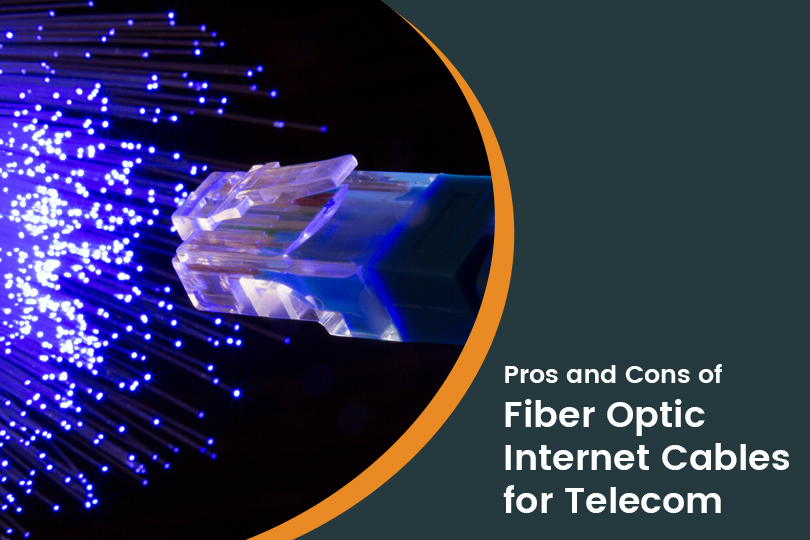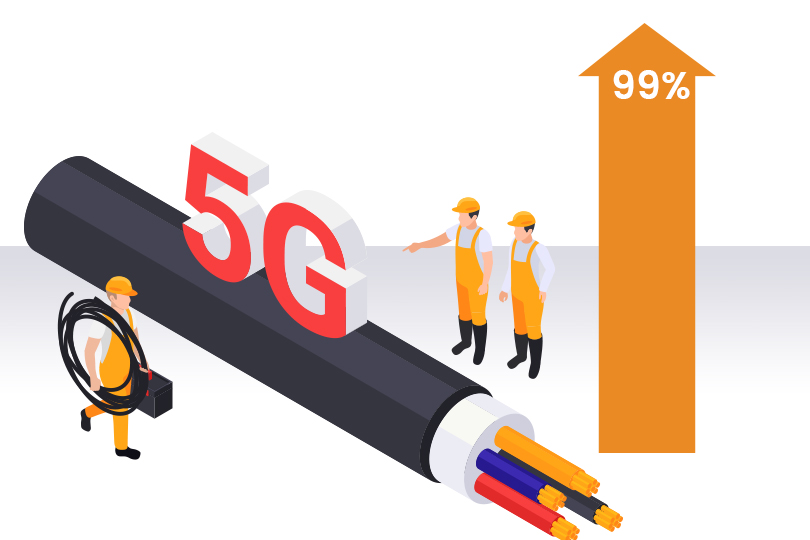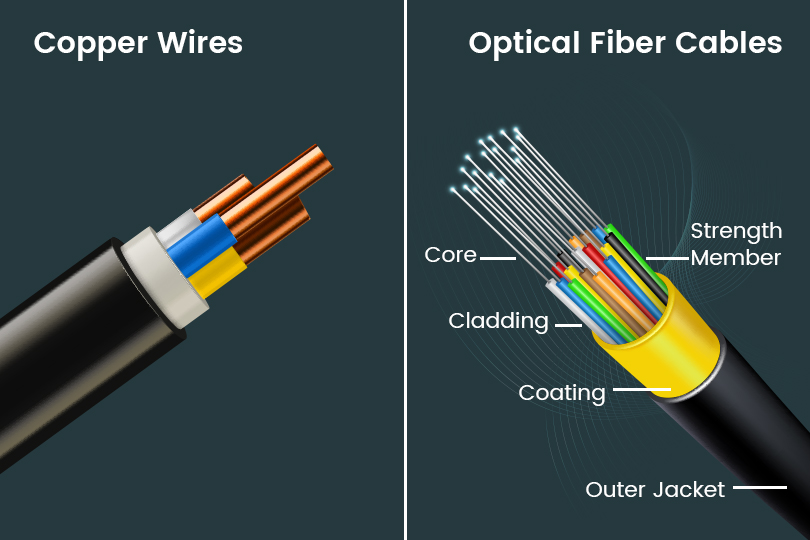Fiber Optic Cables: Advantages and Disadvantages

Fiber-optic transmission has increasingly become the choice when installing new structured network cabling systems due to increasing demands for faster speeds and wider bandwidths. Driven by the rising demand for higher bandwidth and faster speed connections for a variety of industrial and residential purposes, fiber optic transmission is becoming more common in modern society. In fact, if you look around, you’ll discover that fiber optic internet cable has suddenly become the lifeblood of telecommunications all over the world.
Boost your telecom business with Field Promax.Sign up now .
The adoption of fiber optic cables has witnessed an exponential rise due to their unparalleled efficiency. Fiber optic cables’ superior data transfer abilities have long made them the go-to choice in various fields from telecom to internet connectivity, according to a recent report by Global Newswire. According to their estimate of $2.75 billion worldwide in 2016 and expected growth up to 3.72 billion over four years, according to TeleGeography, over 99% of international communications are carried via fiber optic cable systems that run underground 99% of the time today! These statistics suggest that fiber optic transmission is nearing its peak and will significantly alter telecommunications.

Given the increasing popularity of fiber optic internet as well as fiber optic Ethernet cables, it is only evident that they have some significant advantages. Otherwise, people would not have adopted this technology for telecom business. However, this approach also comes with its own set of drawbacks; therefore, telecom business owners have begun exploring more viable alternatives – an exercise that ultimately boils down to carefully considering both sides.
Are you curious about Fiber cables? Well, look no further; here is where the fun begins. In this blog, we have put together a comprehensive guide to elaborate on the advantages and disadvantages of fiber optic cable.
But before we delve into the comparison, let’s have a quick overview of fiber optic internet cables.
Table of Contents
Fiber Optic Cable: An Overview
Fiber optic cables are slender, hair-thin strands composed of either glass or plastic. Unlike traditional copper cables, which transmit data through electrical signals, fiber optic cables use light signals to transmit information. These cables consist of a core, where light travels, surrounded by a cladding layer that reflects the light inward, ensuring minimal signal loss.
This wire has the look of a cylinder and consists of a core, cladding, coating, strength member, and outer jacket. The core is the thin glass that is used for light transmission and reception, whereas the exterior walls of the core are referred to as the cladding. Cladding functions as a barrier protection shell in this case. Light gets reflected due to the cladding, and hence it can be easily transported through the core. Coatings and jackets protect the cable from damage.

Characteristics of Fiber Optic Cables:
Following are the unique characteristics of fiber optic cable.
- It can accommodate data transfer much faster than copper wire versions such as coaxial and twisted pair cables.
- Data can be sent as pulses of light over threads of glass at Gbps.
- Lines are free of EM (electromagnetic) interference, and hence they are difficult to tap by hackers.
- Data can travel for miles without signal degradation.
- These cables are more immune to environmental extremes. They can operate over large variations in temperature. Moreover, they are not affected by corrosive liquids and gases.
- They are non-conductors and hence there are no shock hazards as no current or voltage is associated with them.
- They’re small in size and lightweight, which makes installation much simpler.
Advantages of Fiber Optic Cables
- High Bandwidth
- Fast Data Transfer Speeds
- Low Latency
- Reliability
- Long Transmission Distances
- Security
Fiber optic cables boast impressive bandwidth capacities that enable them to carry large amounts of information without degrading in speed or quality, making them suitable for applications requiring high data transfer rates, such as streaming media content, online gaming, or video conferencing.
One of the primary advantages of fiber optic cables is their amazing speed. Their use of light signals enables these cables to transmit data at speeds far greater than traditional copper cables can achieve. Fiber optic internet cables, in particular, deliver blazing-fast internet speeds, ensuring a seamless online experience for users.
Fiber optic cables minimize latency, the delay between data transmission and reception. This is crucial for applications that require real-time interaction, like online gaming and video calls. The low latency provided by fiber optic Ethernet cables contributes to a smoother and more responsive network experience.
Fiber optic cables are highly reliable, even in challenging conditions. They are immune to electromagnetic interference, unlike copper cables, which can be affected by nearby electrical equipment. This makes fiber optic cables a robust choice for areas with high electromagnetic interference, ensuring consistent and reliable data transmission.
Fiber optic cables can transmit data over much longer distances without the need for signal boosters. This characteristic is particularly advantageous in telecommunications and networking infrastructure, where signals need to traverse extensive networks.
Fiber optic internet cables provide a higher level of security compared to traditional cables. Since they transmit data using light signals, it’s challenging to tap into the cable and intercept information. This inherent security feature makes fiber optic cables an attractive option for transmitting sensitive data.
Disadvantages of Fiber Optic Cables:
- Cost
- Fragility
- Limited Flexibility
- Power Dependency
- Complex Repairs
- Limited Compatibility
One of the primary drawbacks of fiber optic cables is the initial installation cost. The process of laying down fiber optic infrastructure involves specialized equipment and skilled technicians, contributing to higher upfront expenses. However, it’s important to note that the long-term benefits often outweigh the initial investment.
Fiber optic internet cables, especially those with glass cores, can be fragile. They are susceptible to bending and twisting, which may result in signal loss. Careful handling during installation and maintenance is essential to prevent damage to the cables.
Unlike copper cables, which can be easily bent and routed, fiber optic cables have limited flexibility. This can pose challenges in certain installation scenarios where tight bends or twists are required. It’s crucial to plan the cable routes carefully to avoid signal degradation.
Fiber optic systems requiring external power sources, like those containing active components like repeaters or signal boosters, may experience a loss of functionality during power outages. Passive optical networks (PONs), on the other hand, eliminate this dependency but have their own set of restrictions and requirements that must be fulfilled for them to function optimally.
In the event of a fiber optic cable failure, repairs can be complex and time-consuming. Locating and fixing a break or damage to the cable requires specialized equipment and expertise. This can result in longer downtime compared to the relatively simpler repairs of traditional copper cables.
While the adoption of fiber optic technology is growing, there are still areas where it may not be readily available. This limited availability may affect its compatibility with existing infrastructure in certain regions, making it challenging for widespread implementation.
As we navigate the complex web of advantages and disadvantages, fiber optic internet cables have emerged as essential elements in our interconnected world. Their high-speed data transfer capabilities have transformed how we communicate, work, and entertain ourselves, although their initial costs and fragility might pose challenges to their use. However, over time, their speed, reliability, and security benefits will firmly establish them as indispensable contributors to the digital future. Telco business owners typically cite fiber optic Ethernet cables’ installation, maintenance, and repair processes as being costly and time-consuming, yet that no longer holds.
If you are remotely aware of the changing trends in the field service industry, you would know that these critical operations have become easier than ever before with emerging technologies like Field Promax. Not only do advanced field service management software solutions streamline the repair and maintenance of fiber optic cables, but they also significantly reduce operational costs, thus eliminating one of the major obstacles.
So, now you know not only about fiber optic cable advantages and disadvantages but also about a great tool that you have easily at your disposal to take on the challenges. Make sure to leverage it.
For more information contact Field Promax today.






